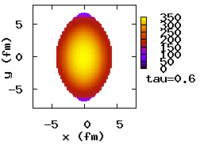gnuplot [script-filename]Or if you are a beginner, after going into gnuplot (without filename), type
help plotthen you will see some explanations.
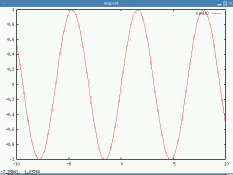
$ gnuplot
G N U P L O T
Version 4.0 patchlevel 0
....
Terminal type set to 'x11'
gnuplot> help plot
`plot` is the primary command for drawing plots with `gnuplot`. ...
Syntax:
plot {}
{ | {"" {datafile-modifiers}}}
...
gnuplot> quit
$
One of the simplest sample is the following.
$ gnuplot G N U P L O T Version 4.0 patchlevel 0 .... Terminal type set to 'x11' gnuplot> plot sin(x) gnuplot> quit $
The figure below is a sample output of gnuplot4.0. The horizontal axis is the type of points, and the vertical axis is the type of lines. (They are not K+ momentum etc.!!) The script file is here, and its output EPS file is here.
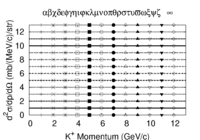
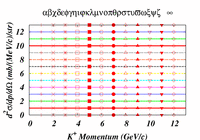
|
Line and point color is specified by the linetype.
| linetype(lt)-color and lt-dash correspondence in gnuplot 4.0 | ||||||||||
| lt | 1 | 2 | 3 | 4 | 5 | 6 | 7 | 8 | 9 | lt>10 |
| color | red | green | blue | magenta | lightblue | yellow | black | orange | grey | color @ mod(lt-1,9)+1 |
| dashed type | solid | dashed | short dashed | dotted | dot dashed | dot short dashed | ... | ... | ... | dash @ mod(lt-1,9)+1 |
The script file of color PS output is here, and its PS (eps) output is here.
The above number-color correspondence in gnuplot-4.0 is the same in gnuplot-3.7. But the "linestyle" in 3.7 has to be replaced with "style line".
set linestyle 1 lt 1 lw 6 # in gnuplot 3.7 script set style line 1 lt 1 lw 6 # in gnuplot 4.0 script
set term postscript set output "YOUR-OUTPUT-FILE-NAME"and plot the figure. Then the figure is saved in the PS file which you specified.
| Interactive Session Example | Script Session Example |
$ gnuplot gnuplot> set term postscript gnuplot> set output "YOUR-OUTPUT-FILE-NAME" gnuplot> plot ... gnuplot> quit $ lpr YOUR-OUTPUT-FILE-NAME |
$ gnuplot sin.plt $ lpr sin.pswith a test gnuplot script (sin.plt) as, set term postscript eps color enh "Times-BoldItalic" set title "sin(x)" set output "sin.ps" plot sin(x) |
You can put Greek and other character or symbols in postscript. Guide is here.
-
Example of 3D plot.
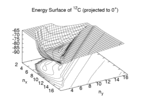 Energy Surface of 12C, taken from
our paper.
By using "splot", we can draw surface and contours.
Energy Surface of 12C, taken from
our paper.
By using "splot", we can draw surface and contours.
-
Example to Draw Contour in 2D plot.
Drawing contour in 2D plot is not a trivial task.... When we try to draw 2D contour by using "set view 0,0" (as in this script), y-axis is drawn in the right axis, and the contour line type cannot be specified, as in the left figure.
Thus I usually do this in two steps. In the first step, I output the contour data in "tables", and in the second step, I plot that data.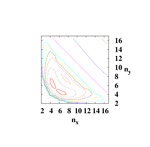
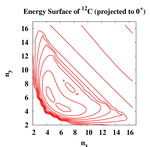
# 1st step set term "table" set output "temp.dat" splot .... # 2nd step set output "temp.eps" plot "temp.dat" using 1:2 with lines
-
Example of Multiplot by using functions
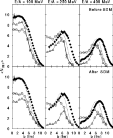 Impact parameter dependence of the IMFs in 197Au+
197Au collision, taken from
our paper.
In gnuplot3.6beta, we can call functions from data,
e.g., "plot 'datafile' using 1:(f($2))".
This enables us to plot some figures in one plot,
if you are patient.
You can also use "set multiplot", when the figures
are not connected.
Impact parameter dependence of the IMFs in 197Au+
197Au collision, taken from
our paper.
In gnuplot3.6beta, we can call functions from data,
e.g., "plot 'datafile' using 1:(f($2))".
This enables us to plot some figures in one plot,
if you are patient.
You can also use "set multiplot", when the figures
are not connected.
-
Example of Multiplot
Effective free energy as a function of the chiral condensate is taken from our paper. In recent gnuplot (3.6beta340 or later), we can set bmargin (bottom margin), tmargin, lmargin, and rmargin in plot and multiplot. It means that, without any functional transform, drawing axis by hand, or fine tuning of the position of figures in multiplot, we can draw compactly packed figures.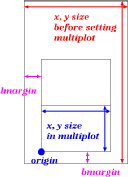
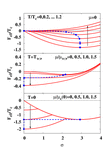
NX=1; NY=3 DX=0.25; DY=0.25; SX=0.8; SY=0.6 set bmargin DX; set tmargin DX; set lmargin DY; set rmargin DY set size SX*NX+DX*1.5,SY*NY+DY*1.8 set multiplot # First Figure set size SX,SY set origin DX,DY ; plot .... # Second Figure set origin DX,DY+SY ; plot .... # Third Figure set origin DX,DY+SY*2 ; plot .... unset multiplot
In this figure, I applied another trick. In making color PS figures, we cannot control color and dashed type separately. I.e., when we select solid (set term post solid ...), all the lines become solid, and when we select dashed (set term post dashed ...), red line is solid, green line is dashed, and blue line becomes dotted.
(In the next version of gnuplot, gnuplot-4.1 or current CVS version, we can select "red-dotted" or "blue-solid".)
At present, I MODIFY the eps file itself.Default (black, dashed): /LT6 { PL [2 dl 2 dl 2 dl 4 dl] 0 0 0 DL } def --> Modified (black, solid): /LT6 { PL [] 0 0 0 DL } defWell, it would be easy in stream editor, sed.sed -f LT6-solid.sed Esurf.eps > Esurf-1.eps mv -f Esurf-1.eps Esurf.eps
with a sed script (LT6-solid.sed),s/\/LT6 { PL \[2 dl 2 dl 2 dl 4 dl\] 0 0 0 DL } def/\/LT6 { PL \[\] 0 0 0 DL } def/

-
Nuclear Chart
Combining awk and gnuplot, we can make nuclear chart as follows.
-
To be explained ...
Folloing two figures are also drawn with gnuplot. I will explain later (some time ....)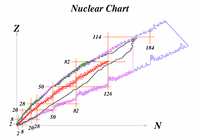
package